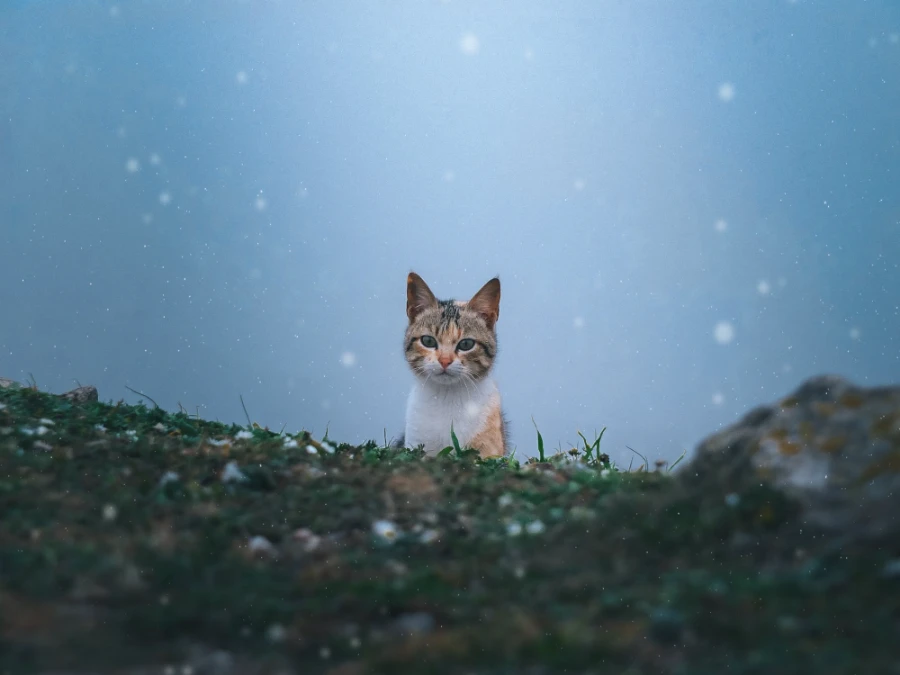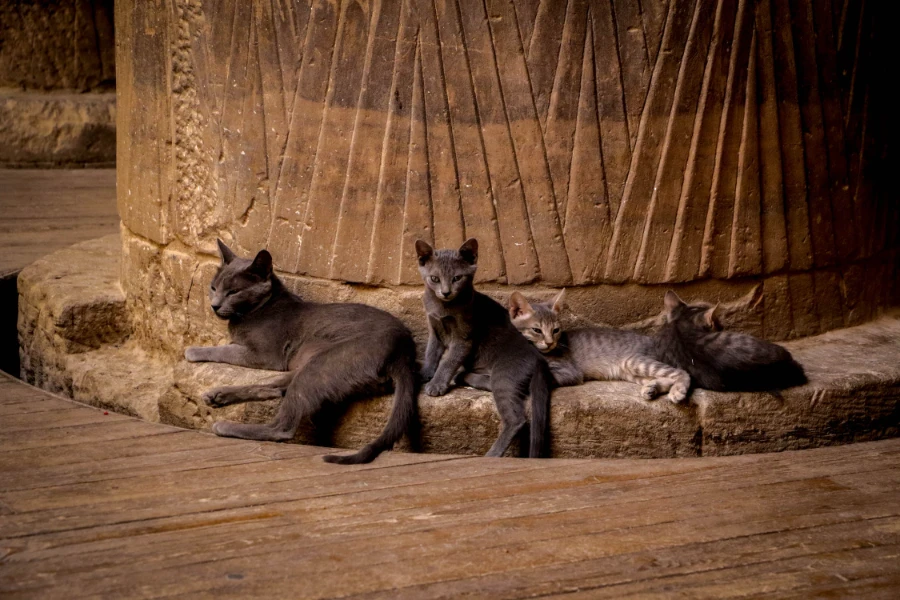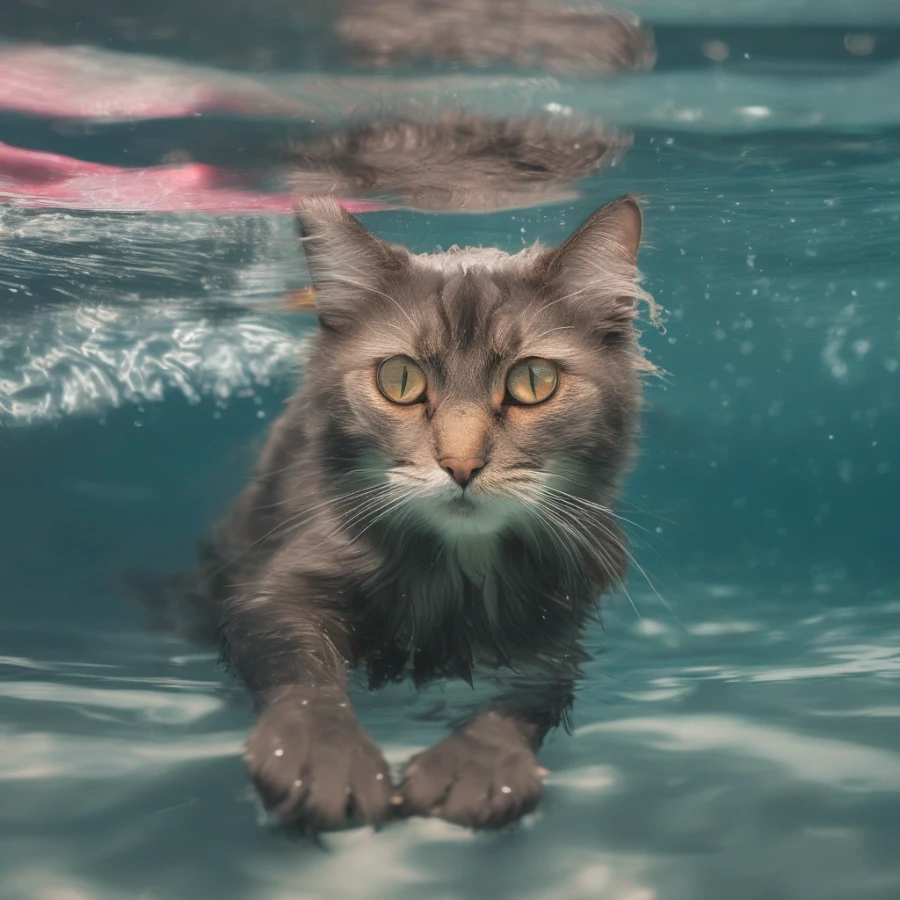How Long Do Feral Cats Stay with Their Kittens: A Crucial Period of Maternal Care

Published by: Tatsiana Korshik
Time to Read: 5 Min

Understanding the dynamics of feral cat behavior, particularly how long they stay with their kittens, is crucial for cat owners who love and care for pets.
Typically, feral cats, despite their independent nature, invest a significant amount of time in maternal care. The average period during which a feral cat stays with her kittens spans approximately 5 to 7 weeks. This timeframe is crucial for the development and well-being of the kittens.
During this period, the mother cat assumes a vital role in nurturing her offspring. She provides warmth, protection, and imparts essential survival skills. This hands-on approach contributes to the physical and emotional growth of the kittens, ensuring they are well-prepared for the challenges of the environment they will eventually face.
The 5 to 7 weeks of maternal care also encompass the weaning process. Around the fourth week, the mother cat begins introducing solid food to her kittens while gradually reducing nursing sessions. This transitional phase prepares the kittens for a more self-reliant life.
As the seventh week approaches, feral kittens are typically weaned and ready to explore a life with less dependence on their mother. The mother cat, in turn, encourages independence in her offspring. By the eighth to twelfth week, feral kittens often disperse, establishing their territories and adapting to a more autonomous lifestyle.
It's important to note that various factors can influence the duration of maternal care. Environmental conditions, the overall health of the kittens, and the availability of resources in their surroundings are all contributing factors to this feral cat family dynamic.
Around the fourth week of their lives, feral kittens begin the weaning process under the guidance of their mother. During this period, the mother cat introduces solid food to the kittens' diet, initiating a gradual shift away from dependence on nursing. This transition serves as a fundamental preparation for the kittens to lead more independent lives.
Weaning is a carefully orchestrated process that lasts until approximately the seventh week. As the kittens adapt to consuming solid food, they become less reliant on their mother's milk. This not only aids in their physical development but also teaches them essential skills for survival.
This period is critical for the mother cat as well, as she encourages her kittens to explore and interact with their surroundings. The weaning process establishes a foundation for the kittens to develop independence, preparing them for the challenges they will encounter in the feral environment.
Understanding the intricacies of the weaning process provides cat owners with valuable insights into the natural progression of feral cat families. It is a testament to the adaptability and resilience of these feline creatures, ensuring the well-being of the kittens as they transition from reliance on their mother's care to a more self-sufficient way of life.
For cat owners who have a deep love for their feline companions, understanding this specific timeframe provides valuable insights into the natural behaviors of feral cats. Armed with this knowledge, you can approach the care and welfare of feral cat families in your community with greater understanding and empathy.
For cat owners who hold a special place in their hearts for their feline companions, understanding the phase of independence and dispersal in feral kittens is essential.
After the weaning process, typically occurring around the seventh week, feral kittens embark on a journey towards independence. The mother cat, having played a crucial role in their early development, now encourages her offspring to explore the world on their own.
During the eighth to twelfth week, feral kittens undergo a significant transformation as they disperse from their mother. This period marks the establishment of individual territories and the development of skills necessary for survival in the wild.
The mother cat's role during this phase is to guide her kittens in navigating their surroundings, allowing them to gradually distance themselves and adapt to life without constant maternal presence. This process not only contributes to the kittens' autonomy but also ensures the continued growth of the feral cat family.
Factors such as environmental conditions, the availability of resources, and the overall health of the kittens can influence the timing and success of this transition. Understanding the dynamics of independence and dispersal provides cat owners with insights into the resilience and adaptability of feral kittens as they navigate the challenges of their environment.
Armed with this knowledge, cat owners who love their pets can appreciate the natural progression of feral cat families and approach their care and welfare in the community with a deeper understanding of these remarkable creatures.
1. Environmental Conditions: The surroundings play a pivotal role in determining how long a feral cat stays with her kittens. Adequate shelter, availability of food, and a secure environment can positively impact the duration of maternal care.
2. Health of the Kittens: The overall health and well-being of the kittens are significant factors. In instances where kittens face health challenges or vulnerabilities, the mother cat may extend her stay to provide extra care and protection.
3. Availability of Resources: Access to resources like food and water influences the maternal care duration. If resources are abundant, the mother cat may feel more secure in providing extended care to ensure her kittens' optimal development.
4. Survival Instincts: Feral cats are inherently driven by survival instincts. The mother cat may adjust the duration of maternal care based on her assessment of the kittens' readiness to navigate the challenges of their environment independently.
Understanding these factors helps cat owners comprehend the intricacies of feral cat family dynamics. By recognizing the environmental and situational elements influencing stay duration, you can approach the care of feral cat families with empathy and a nuanced understanding of their unique needs.
1. TNR Programs and Population Control: TNR programs aim to control the feral cat population by trapping, neutering or spaying, and returning them to their original location. This practice helps stabilize and reduce the overall population of feral cats in a community.
2. Altered Maternal Care Dynamics: In TNR-managed feral cat colonies, the traditional duration of maternal care may vary. With controlled breeding, mother cats might experience different behaviors, potentially altering the typical 5 to 7-week duration of maternal care.
3. Colony Dynamics and Social Structures: Feral cat colonies under TNR programs often develop unique social structures. The presence of neutered or spayed cats, coupled with managed resources, can influence how long a mother cat stays with her kittens and how the kittens interact within the colony.
4. Impact on Feral Cat Families: While TNR programs are beneficial for controlling the population and improving the overall well-being of feral cats, they can also affect the dynamics of feral cat families. Kittens in managed colonies may experience a different trajectory in terms of maternal care and independence.
Understanding the interplay between TNR programs and feral cat colonies provides cat owners with a broader perspective on the challenges and benefits associated with feral cat population management. As you navigate the world of feral cat welfare, acknowledging these nuances can guide your approach to caring for these communities in a compassionate and informed manner.
Feral cats, despite their independent nature, exhibit a surprisingly strong sense of maternal care. On average, a feral cat will stay with her kittens for about 5 to 7 weeks.
During this timeframe, the mother cat plays a vital role in nurturing her offspring. She provides warmth, protection, and imparts essential survival skills to her kittens.
The weaning process begins around the fourth week. It involves introducing solid food to the kittens' diet while gradually reducing nursing sessions. By the end of the seventh week, feral kittens are typically weaned.
After weaning, the mother cat encourages independence in her offspring. Feral kittens, around the eighth to twelfth week, often disperse, establishing their territories and adapting to a more independent lifestyle.
Environmental conditions, health of the kittens, and the availability of resources can impact how long a feral cat stays with her kittens. Survival instincts also play a role in shaping the duration of maternal care.
Duration of Maternal Care
When it comes to understanding feral cat behavior, the duration of maternal care plays a pivotal role, especially for cat owners like you who deeply care for their pets.Typically, feral cats, despite their independent nature, invest a significant amount of time in maternal care. The average period during which a feral cat stays with her kittens spans approximately 5 to 7 weeks. This timeframe is crucial for the development and well-being of the kittens.
During this period, the mother cat assumes a vital role in nurturing her offspring. She provides warmth, protection, and imparts essential survival skills. This hands-on approach contributes to the physical and emotional growth of the kittens, ensuring they are well-prepared for the challenges of the environment they will eventually face.
The 5 to 7 weeks of maternal care also encompass the weaning process. Around the fourth week, the mother cat begins introducing solid food to her kittens while gradually reducing nursing sessions. This transitional phase prepares the kittens for a more self-reliant life.
As the seventh week approaches, feral kittens are typically weaned and ready to explore a life with less dependence on their mother. The mother cat, in turn, encourages independence in her offspring. By the eighth to twelfth week, feral kittens often disperse, establishing their territories and adapting to a more autonomous lifestyle.
It's important to note that various factors can influence the duration of maternal care. Environmental conditions, the overall health of the kittens, and the availability of resources in their surroundings are all contributing factors to this feral cat family dynamic.
The Weaning Process: A Pivotal Transition in Feral Cat Families
The weaning process marks a crucial phase in the development of feral kittens and is of particular significance for devoted cat owners like you.Around the fourth week of their lives, feral kittens begin the weaning process under the guidance of their mother. During this period, the mother cat introduces solid food to the kittens' diet, initiating a gradual shift away from dependence on nursing. This transition serves as a fundamental preparation for the kittens to lead more independent lives.
Weaning is a carefully orchestrated process that lasts until approximately the seventh week. As the kittens adapt to consuming solid food, they become less reliant on their mother's milk. This not only aids in their physical development but also teaches them essential skills for survival.
This period is critical for the mother cat as well, as she encourages her kittens to explore and interact with their surroundings. The weaning process establishes a foundation for the kittens to develop independence, preparing them for the challenges they will encounter in the feral environment.
Understanding the intricacies of the weaning process provides cat owners with valuable insights into the natural progression of feral cat families. It is a testament to the adaptability and resilience of these feline creatures, ensuring the well-being of the kittens as they transition from reliance on their mother's care to a more self-sufficient way of life.
For cat owners who have a deep love for their feline companions, understanding this specific timeframe provides valuable insights into the natural behaviors of feral cats. Armed with this knowledge, you can approach the care and welfare of feral cat families in your community with greater understanding and empathy.
Independence and Dispersal: Feral Kittens' Transition to Autonomy

For cat owners who hold a special place in their hearts for their feline companions, understanding the phase of independence and dispersal in feral kittens is essential.
After the weaning process, typically occurring around the seventh week, feral kittens embark on a journey towards independence. The mother cat, having played a crucial role in their early development, now encourages her offspring to explore the world on their own.
During the eighth to twelfth week, feral kittens undergo a significant transformation as they disperse from their mother. This period marks the establishment of individual territories and the development of skills necessary for survival in the wild.
The mother cat's role during this phase is to guide her kittens in navigating their surroundings, allowing them to gradually distance themselves and adapt to life without constant maternal presence. This process not only contributes to the kittens' autonomy but also ensures the continued growth of the feral cat family.
Factors such as environmental conditions, the availability of resources, and the overall health of the kittens can influence the timing and success of this transition. Understanding the dynamics of independence and dispersal provides cat owners with insights into the resilience and adaptability of feral kittens as they navigate the challenges of their environment.
Armed with this knowledge, cat owners who love their pets can appreciate the natural progression of feral cat families and approach their care and welfare in the community with a deeper understanding of these remarkable creatures.
Factors Influencing Stay Duration: Understanding the Dynamics of Feral Cat Maternal Care
For cat owners who cherish their feline companions, delving into the factors that influence the duration of maternal care in feral cats provides valuable insights into these creatures' complex dynamics.1. Environmental Conditions: The surroundings play a pivotal role in determining how long a feral cat stays with her kittens. Adequate shelter, availability of food, and a secure environment can positively impact the duration of maternal care.
2. Health of the Kittens: The overall health and well-being of the kittens are significant factors. In instances where kittens face health challenges or vulnerabilities, the mother cat may extend her stay to provide extra care and protection.
3. Availability of Resources: Access to resources like food and water influences the maternal care duration. If resources are abundant, the mother cat may feel more secure in providing extended care to ensure her kittens' optimal development.
4. Survival Instincts: Feral cats are inherently driven by survival instincts. The mother cat may adjust the duration of maternal care based on her assessment of the kittens' readiness to navigate the challenges of their environment independently.
Understanding these factors helps cat owners comprehend the intricacies of feral cat family dynamics. By recognizing the environmental and situational elements influencing stay duration, you can approach the care of feral cat families with empathy and a nuanced understanding of their unique needs.
TNR Programs and Feral Cat Colonies: Shaping Feral Cat Family Dynamics
Cat owners who hold a deep affection for their pets may find it enlightening to explore the impact of Trap-Neuter-Return (TNR) programs on feral cat colonies, altering the dynamics of maternal care and family structures.1. TNR Programs and Population Control: TNR programs aim to control the feral cat population by trapping, neutering or spaying, and returning them to their original location. This practice helps stabilize and reduce the overall population of feral cats in a community.
2. Altered Maternal Care Dynamics: In TNR-managed feral cat colonies, the traditional duration of maternal care may vary. With controlled breeding, mother cats might experience different behaviors, potentially altering the typical 5 to 7-week duration of maternal care.
3. Colony Dynamics and Social Structures: Feral cat colonies under TNR programs often develop unique social structures. The presence of neutered or spayed cats, coupled with managed resources, can influence how long a mother cat stays with her kittens and how the kittens interact within the colony.
4. Impact on Feral Cat Families: While TNR programs are beneficial for controlling the population and improving the overall well-being of feral cats, they can also affect the dynamics of feral cat families. Kittens in managed colonies may experience a different trajectory in terms of maternal care and independence.
Understanding the interplay between TNR programs and feral cat colonies provides cat owners with a broader perspective on the challenges and benefits associated with feral cat population management. As you navigate the world of feral cat welfare, acknowledging these nuances can guide your approach to caring for these communities in a compassionate and informed manner.
Conclusion
Understanding how long feral cats stay with their kittens sheds light on the natural behaviors of these independent creatures. For cat owners caring for feral cat families or those encountering them in their communities, this knowledge contributes to creating a compassionate and informed approach to feline welfare.How Long Do Feral Cats Stay with Their Kittens FAQ
How long do feral cats typically stay with their kittens?
Feral cats, despite their independent nature, exhibit a surprisingly strong sense of maternal care. On average, a feral cat will stay with her kittens for about 5 to 7 weeks.
What happens during this period of maternal care?
During this timeframe, the mother cat plays a vital role in nurturing her offspring. She provides warmth, protection, and imparts essential survival skills to her kittens.
What is the weaning process, and when does it occur?
The weaning process begins around the fourth week. It involves introducing solid food to the kittens' diet while gradually reducing nursing sessions. By the end of the seventh week, feral kittens are typically weaned.
What follows the weaning process?
After weaning, the mother cat encourages independence in her offspring. Feral kittens, around the eighth to twelfth week, often disperse, establishing their territories and adapting to a more independent lifestyle.
What factors influence the duration of maternal care?
Environmental conditions, health of the kittens, and the availability of resources can impact how long a feral cat stays with her kittens. Survival instincts also play a role in shaping the duration of maternal care.



